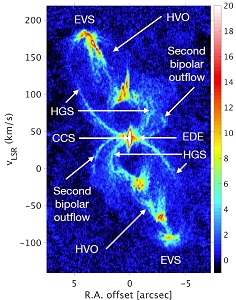- Details
- Published on 25 March 2019
Vol. 623
In section 6. Interstellar and circumstellar matter
HD101584: circumstellar characteristics and evolutionary status
 There is growing evidence that red giant evolution is often affected by an interplay with a nearby companion, in some cases taking the form of a common-envelope evolution. This paper presents an ALMA/APEX molecular line study study of 12 molecular species, which are used to characterize the circumstellar environment of the binary system HD 101584 at extremely high spatial resolution (from 0.1arcsec - 0.6arcsec). HD 101584 is an optically bright system with a large far-infrared excess, believed to have as a primary a 0.55Msun post-AGB star. Photometric and radial velocity variations have resulted in a companion mass estimate of 0.6Msun.
Four distinct components are identified in these new ALMA/APEX data: a central compact source, a flattened equatorial density distribution in the plane of the orbit, a high-velocity bipolar outflow along the line of sight, and an hourglass structure. The authors determine the mass of gas and dust in the system, and note that a substantial fraction of the dust is in the form of large (1mm) grains. They determine the kinetic age, energy, and scalar momentum of the outflow.
This work provides concrete evidence that HD 101584 is in a post-common-envelope evolution phase, which ended avoiding a stellar merger. Isotope ratios combined with stellar mass estimates suggest that the primary star's evolution had already been terminated on the first red giant branch, that is, it is a post-RGB star and the companion mass is now estimated to be 0.27Msun. Most of the energy required to drive the outflowing gas could have been released when material fell towards the companion.
There is growing evidence that red giant evolution is often affected by an interplay with a nearby companion, in some cases taking the form of a common-envelope evolution. This paper presents an ALMA/APEX molecular line study study of 12 molecular species, which are used to characterize the circumstellar environment of the binary system HD 101584 at extremely high spatial resolution (from 0.1arcsec - 0.6arcsec). HD 101584 is an optically bright system with a large far-infrared excess, believed to have as a primary a 0.55Msun post-AGB star. Photometric and radial velocity variations have resulted in a companion mass estimate of 0.6Msun.
Four distinct components are identified in these new ALMA/APEX data: a central compact source, a flattened equatorial density distribution in the plane of the orbit, a high-velocity bipolar outflow along the line of sight, and an hourglass structure. The authors determine the mass of gas and dust in the system, and note that a substantial fraction of the dust is in the form of large (1mm) grains. They determine the kinetic age, energy, and scalar momentum of the outflow.
This work provides concrete evidence that HD 101584 is in a post-common-envelope evolution phase, which ended avoiding a stellar merger. Isotope ratios combined with stellar mass estimates suggest that the primary star's evolution had already been terminated on the first red giant branch, that is, it is a post-RGB star and the companion mass is now estimated to be 0.27Msun. Most of the energy required to drive the outflowing gas could have been released when material fell towards the companion.


